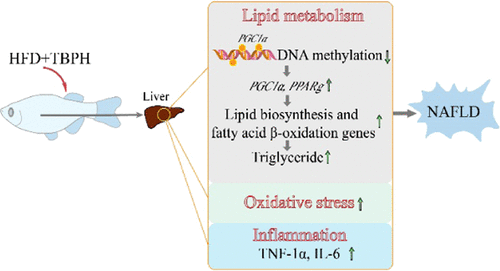当前位置:
X-MOL 学术
›
Environ. Sci. Technol.
›
论文详情
Our official English website, www.x-mol.net, welcomes your
feedback! (Note: you will need to create a separate account there.)
Nonalcoholic Fatty Liver Disease Development in Zebrafish upon Exposure to Bis(2-ethylhexyl)-2,3,4,5-tetrabromophthalate, a Novel Brominated Flame Retardant
Environmental Science & Technology ( IF 10.8 ) Pub Date : 2021-05-02 , DOI: 10.1021/acs.est.1c01476 Wei Guo 1, 2 , Lei Lei 1, 2 , Xiongjie Shi 3 , Ruiwen Li 4 , Qiangwei Wang 5 , Jian Han 1 , Lihua Yang 1 , Lianguo Chen 1 , Bingsheng Zhou 1
Environmental Science & Technology ( IF 10.8 ) Pub Date : 2021-05-02 , DOI: 10.1021/acs.est.1c01476 Wei Guo 1, 2 , Lei Lei 1, 2 , Xiongjie Shi 3 , Ruiwen Li 4 , Qiangwei Wang 5 , Jian Han 1 , Lihua Yang 1 , Lianguo Chen 1 , Bingsheng Zhou 1
Affiliation

|
Bis(2-ethylhexyl)-2,3,4,5-tetrabromophthalate (TBPH), a novel brominated flame retardant, can potentially cause lipid metabolism disorder; however, its biological effects on lipid homeostasis remain unknown. We investigated its ability to cause nonalcoholic fatty liver disease (NAFLD) in zebrafish. Female zebrafish were fed a high-fat diet (HFD, 24% crude fat) or normal diet (ND, 6% crude fat), and exposed to TBPH (0.02, 2.0 μM) for 2 weeks. Consequently, HFD-fed fish showed a higher measured concentration of TBPH than ND-fed fish. Further, TBPH-treated fish in the HFD group showed higher hepatic triglyceride levels and steatosis. In comparison to ND-fed fish, treating HFD-fed fish with TBPH led to an increase in the concentration of several proinflammatory markers (e.g., TNF-α, IL-6); TBPH exposure also caused oxidative stress. In addition, the mRNA levels of genes encoding peroxisome proliferator-activated receptors were increased, and the transcription of genes involved in lipid synthesis, transport, and oxidation was upregulated in both ND- and HFD-fed fish. Both the ND and HFD groups also showed demethylation of the peroxisome proliferator-activated receptor-γ coactivator 1-α gene promoter, accompanied by the upregulation of tet1 and tet2 transcription. To summarize, we found that TBPH amplified the disruption of lipid homeostasis in zebrafish, leading to the enhancement of diet-induced NAFLD progression.
中文翻译:

暴露于新型溴化阻燃剂双(2-乙基己基)-2,3,4,5-四溴邻苯二甲酸酯中的斑马鱼非酒精性脂肪肝疾病的发展。
新型溴化阻燃剂双(2-乙基己基)-2,3,4,5-四溴邻苯二甲酸酯(TBPH)可能引起脂质代谢紊乱。然而,其对脂质稳态的生物学影响仍然未知。我们调查了其在斑马鱼中引起非酒精性脂肪肝疾病(NAFLD)的能力。给雌性斑马鱼喂食高脂饮食(HFD,24%粗脂肪)或正常饮食(ND,6%粗脂肪),并暴露于TBPH(0.02,2.0μM)2周。因此,HFD喂养的鱼比ND喂养的鱼表现出更高的TBPH浓度。此外,HFD组中经TBPH处理的鱼显示出较高的肝甘油三酸酯水平和脂肪变性。与ND饲喂的鱼相比,用TBPH处理HFD饲喂的鱼导致了几种促炎性标志物(例如TNF-α,IL-6)的浓度增加。TBPH暴露也引起氧化应激。此外,ND和HFD喂养的鱼类中,过氧化物酶体增殖物激活的受体的编码基因的mRNA水平增加,参与脂质合成,转运和氧化的基因的转录也被上调。ND组和HFD组均显示过氧化物酶体增殖物激活的受体-γ共激活物1-α基因启动子的去甲基化,同时伴随着HGF的上调。tet1和tet2转录。总而言之,我们发现TBPH放大了斑马鱼中脂质稳态的破坏,从而导致饮食诱导的NAFLD进程的增强。
更新日期:2021-05-18
中文翻译:

暴露于新型溴化阻燃剂双(2-乙基己基)-2,3,4,5-四溴邻苯二甲酸酯中的斑马鱼非酒精性脂肪肝疾病的发展。
新型溴化阻燃剂双(2-乙基己基)-2,3,4,5-四溴邻苯二甲酸酯(TBPH)可能引起脂质代谢紊乱。然而,其对脂质稳态的生物学影响仍然未知。我们调查了其在斑马鱼中引起非酒精性脂肪肝疾病(NAFLD)的能力。给雌性斑马鱼喂食高脂饮食(HFD,24%粗脂肪)或正常饮食(ND,6%粗脂肪),并暴露于TBPH(0.02,2.0μM)2周。因此,HFD喂养的鱼比ND喂养的鱼表现出更高的TBPH浓度。此外,HFD组中经TBPH处理的鱼显示出较高的肝甘油三酸酯水平和脂肪变性。与ND饲喂的鱼相比,用TBPH处理HFD饲喂的鱼导致了几种促炎性标志物(例如TNF-α,IL-6)的浓度增加。TBPH暴露也引起氧化应激。此外,ND和HFD喂养的鱼类中,过氧化物酶体增殖物激活的受体的编码基因的mRNA水平增加,参与脂质合成,转运和氧化的基因的转录也被上调。ND组和HFD组均显示过氧化物酶体增殖物激活的受体-γ共激活物1-α基因启动子的去甲基化,同时伴随着HGF的上调。tet1和tet2转录。总而言之,我们发现TBPH放大了斑马鱼中脂质稳态的破坏,从而导致饮食诱导的NAFLD进程的增强。











































 京公网安备 11010802027423号
京公网安备 11010802027423号